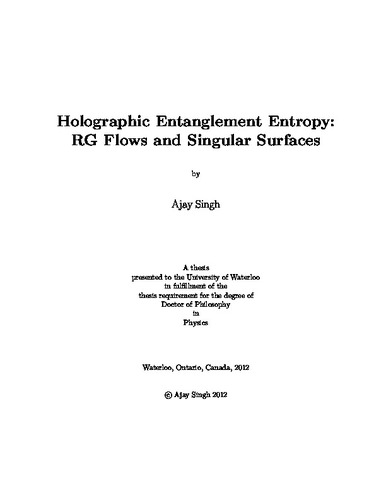| dc.description.abstract | Over the past decade, the AdS/CFT correspondence has proven to be a remarkable tool to study various properties of strongly coupled field theories. In the context of the holography, Ryu and Takayanagi have proposed an elegant method to calculate entanglement entropy for these field theories. In this thesis, we use this holographic entanglement entropy to study a candidate c-theorem and entanglement entropy for singular surfaces.
We use holographic entanglement entropy for strip geometry and construct a candidate c-function in arbitrary dimensions. For holographic theories dual to Einstein gravity, this c-function is shown to decrease monotonically along RG flows. A sufficient condition required for this monotonic flow is that the stress tensor of the matter fields driving the holographic RG flow must satisfy the null energy condition over the holographic surface used to calculate the entanglement entropy. In the case where the bulk theory is described by Gauss-Bonnet gravity, the latter condition alone is not sufficient to establish the monotonic flow of the c-function. We also observe that for certain holographic RG flows, the entanglement entropy undergoes a ‘phase transition’ as the size of the system grows and as a result, evolution of the c-function may exhibit a discontinuous drop.
Then, we turn towards studying the holographic entanglement entropy for regions with a singular boundary in higher dimensions. Here, we find that various singularities make new universal contributions. When the boundary CFT has an even spacetime dimension, we find that the entanglement entropy of a conical surface contains a term quadratic in the logarithm of the UV cut-off. In four dimensions, the coefficient of this contribution is proportional to the central charge c. A conical singularity in an odd number of spacetime dimensions contributes a term proportional to the logarithm of the UV cut-off. We also study the entanglement entropy for various boundary surfaces with extended singularities. In these cases, extended singularities contribute through new linear or quadratic terms in logarithm only when the locus of the singularity is even dimensional and curved. | en |

